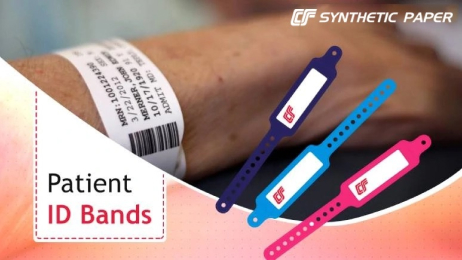Top Features to Look for in a Long-lasting Patient Identification Band
Top Features to Look for in a Long-lasting Patient Identification Band
Blog Article
Exploring the Different Types of Patient Identification Band Made Use Of in Clinical Facilities
In the elaborate world of health care, the crucial duty of Patient Identification bands frequently goes unnoticed. These bands, varying from straightforward paper wristbands to sophisticated RFID bands, form the foundation of Patient safety procedures, making sure accuracy in Patient Identification. The substantial variety of these bands, each with its unique benefits and constraints, is commonly neglected. As we navigate with this subject, one might get insight right into the refined intricacies and important value of such bands in clinical facilities.
Understanding the Importance of Patient Identification Bands
While they might feel like simple accessories, Patient Identification bands play a crucial duty in clinical facilities. These bands function as a vital tool for verifying Patient identity, avoiding clinical mistakes connected to misidentification. The bands usually show necessary details such as the Patient's name, age, blood group, and any type of recognized allergies. They enable healthcare specialists to promptly access this critical info, thereby helping with prompt and accurate medical treatment. Patient Identification bands also help in improving management jobs, making certain exact record-keeping and billing. In spite of their simplicity, these bands symbolize the principle of Patient safety, a keystone of high quality healthcare. Without them, the threat of medical errors, and subsequently, Patient harm, could considerably boost.
Typical Paper Wristbands: Their Use and Limitations
Conventional paper wristbands have actually been a staple in Patient Identification throughout numerous medical facilities. While their use prevails, they nurture specific limitations that may impact their effectiveness in Patient monitoring. This area will certainly focus on the extent of their application and the intrinsic downsides associated with their use.
Paper Wristbands: Usage Scope
In the world of Patient Identification, paper wristbands have long held a crucial function. These bands are generally used in outpatient setups, where the Patient's stay is short-lived. The wristbands contain vital info such as the Patient's name, day of birth, and a distinct Identification number. This simple, yet effective system, permits clinical specialists to quickly and properly recognize patients, making certain the right treatment is carried out. Paper wristbands are additionally utilized in emergency circumstances, where quick Identification is extremely important. Their usage reaches occasions like blood contribution drives and mass inoculation programs, further stressing their versatility. In spite of improvements in innovation, the simple paper wristband continues to be a economical and reliable service for Patient Identification in various healthcare circumstances.
Limitations of Paper Wristbands
In spite of their widespread use, paper wristbands are not without their disadvantages. In addition, paper wristbands frequently do not have the technical capabilities of more modern-day options, such as barcoding or RFID chips, limiting their functionality to just presenting created details. Paper wristbands can create pain or skin irritability to some individuals, especially when worn for prolonged durations.
Barcoded Wristbands: Innovations in Patient Identification
While Patient Identification has actually long been a crucial facet of healthcare, the arrival of barcoded wristbands represents a considerable jump forward. These bands leverage the simpleness of barcoding modern technology, enabling Patient info to be quickly checked and accessed. They boost the speed and accuracy of Patient Identification, lowering the risk of medical mistakes related to article misidentification. Barcoded wristbands are economical, very easy to create, and remove handwriting errors typical with hands-on systems. They are not without restrictions. While site they supply enhancements over typical bands, the barcode can become worn or smudged, making it unreadable. Regardless of this, barcoded wristbands continue to be a vital device in modern health care setups, representing the junction of technology and Patient care.
Superhigh Frequency Identification (RFID) Bands: an Action In The Direction Of Futuristic Health Care
The development of Patient Identification bands has actually brought concerning the emergence of Radio Frequency Identification (RFID) Bands (patient identification band). These innovative devices existing vital benefits for health care facilities, supplying an extra reliable and technically advanced means of Patient Identification. The implementation of RFID in medical care is a substantial action towards a much more futuristic strategy to Patient management and safety and security
Recognizing RFID Bands

RFID Bands: Secret Advantages
Mainly, these bands boost Patient safety and security by providing precise, rapid Identification, thus decreasing clinical mistakes. RFID bands can store a large amount of Patient information, consisting of clinical history and allergies, making it possible for personalized care. Generally, RFID bands stand for a substantial advancement in Patient Identification technology, benefiting both clients and healthcare suppliers.
Implementing RFID in Health Care
As we step into a technologically innovative period, the application of RFID bands in healthcare comes to be why not find out more increasingly important. These bands offer a seamless method to track and determine individuals, guaranteeing their security and enhancing effectiveness in treatment procedures. RFID bands provide various advantages over conventional Identification methods. They can save a substantial quantity of information, including the Patient's medical history and treatment strategies, which can be quickly accessed by doctor. This data aids medical professionals make notified decisions concerning the Patient's treatment plan. Additionally, RFID bands decrease medical errors by providing accurate Patient Identification, which is vital in protecting against misdiagnosis or incorrect medicine management. Thus, the application of RFID bands is a substantial action in the direction of improving Patient safety and medical care distribution.

Color-Coded Wristbands: Aiding in Quick and Accurate Medical Diagnosis
In the bustling setting of a clinical facility, color-coded wristbands have actually arised as essential tools for swift and accurate Identification of a client's clinical condition. These wristbands, worn by individuals, lug details shades that correspond to different clinical problems or statuses. This system is created to supply immediate visual hints to medical care suppliers, enhancing Patient safety and security and care quality.
Techniques for Efficient Execution and Management of Patient ID Bands
Attaining ideal use of Patient Identification bands necessitates a well-structured method for their application and monitoring. Patient education is additionally important; patients have to comprehend the objective of the bands and the requirement for their continuous wear. It's essential to have a back-up plan in location, such as barcode scanning or biometrics, to ensure that Patient Identification is never endangered.
Final thought
Patient Identification bands are critical in clinical centers to make sure safety and accuracy. Typical paper, barcoded, RFID, and color-coded wristbands each hold special advantages, ranging from cost-effectiveness to sophisticated information storage and instantaneous medical notifies. Reliable execution and monitoring of these bands can considerably lower medical errors, improve efficiency, and enhance total Patient treatment. Thus, understanding and using these Identification devices is critical for preserving high criteria in healthcare.
These bands, differing from easy paper wristbands to innovative RFID bands, develop the backbone of Patient safety methods, making certain precision in Patient Identification.The development of Patient Identification bands has actually brought concerning the emergence of Radio Frequency Identification (RFID) Bands. Generally, RFID bands represent a considerable improvement in Patient Identification innovation, benefiting both clients and health care service providers.
RFID bands reduce medical mistakes by offering accurate Patient Identification, which is critical in preventing misdiagnosis or incorrect medicine management. Patient education is likewise crucial; clients should understand the purpose of the bands and the requirement for their consistent wear.
Report this page